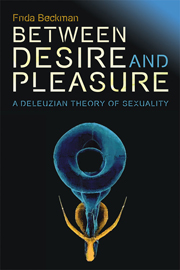Book contents
- Frontmatter
- Contents
- Preface
- Introduction: The Body without Orgasm
- 1 A Nonlinear History of Sexuality: Deleuze with Foucault
- 2 Psychoanalysis Unhinged: Deleuze with Lacan, Klein and Reich
- 3 Folding, Individuation and the Pleasurable Body
- 4 Orgasmic Feminism
- 5 Disabling Sex: Inventing a People who are Missing
- 6 Becoming-Animal and the Posthuman Orgasm
- 7 Capitalism and Sexuality
- Epilogue: Swedish Sin, or the Importance of Remaining Curious
- Bibliography
- Index
3 - Folding, Individuation and the Pleasurable Body
Published online by Cambridge University Press: 05 October 2013
- Frontmatter
- Contents
- Preface
- Introduction: The Body without Orgasm
- 1 A Nonlinear History of Sexuality: Deleuze with Foucault
- 2 Psychoanalysis Unhinged: Deleuze with Lacan, Klein and Reich
- 3 Folding, Individuation and the Pleasurable Body
- 4 Orgasmic Feminism
- 5 Disabling Sex: Inventing a People who are Missing
- 6 Becoming-Animal and the Posthuman Orgasm
- 7 Capitalism and Sexuality
- Epilogue: Swedish Sin, or the Importance of Remaining Curious
- Bibliography
- Index
Summary
Rhythms, regularized patterns of vibration or resonance, are what move from the refrain to the body. What else is both labile enough and appealing enough to slip from its material to its most immaterial effects, from the energy of the universe to the muscular oscillations that constitute pleasure and pain in living things?
(Grosz 2008: 55)Introduction
After outlining some of the central theoretical explanations and impasses that have shaped Deleuze's understanding of desire, pleasure and the orgasm, and before moving on to how specific pleasurable configurations of bodies in literature and culture challenge this understanding, this chapter offers a preliminary exploration of what a Deleuzian theory of the body and pleasure might look like. It also tests such a theory against contemporary conceptualisations of pleasurable bodies more generally. The body as other, as that which bleeds, and leaks, and comes back to haunt us in its glorious but fallible construction, has been of interest to theoretical discourse and cultural expression for centuries. If Descartes broke from earlier Greek philosophies in which the body was not conceived as separate from the mind, Descartes's own mind-body dualism has, in turn, been shattered by modern theories of embodiment. Contemporary research, both in fields such as technology and medicine and in philosophy and culture, increasingly renders any conception of the body as a permanent and separate entity impossible to uphold.
- Type
- Chapter
- Information
- Between Desire and PleasureA Deleuzian Theory of Sexuality, pp. 45 - 69Publisher: Edinburgh University PressPrint publication year: 2013

